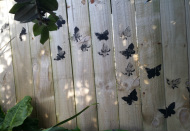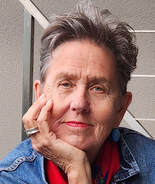All creative people are delighted and thrilled if their work moves, excites or inspires, but would be even more thrilled if they also got a bit of hard cash in exchange for all the imagining, practicing, experimenting, physical labour and materials that go into their art. SLIDESHOW NELSON STREET ART

I knew perfectly well that I was me: I had checked my reflection in the bathroom mirror before I left home. The dog knew I was me too - he’s never yet asked me for I.D. However, the library needed something more than a self-guarantee and a tail-wag from the dog. They would have accepted my driver’s licence as I.D. but that was in my wallet back at home.
In other circumstances, I might have shouted myself a coffee to get over my disappointed plans, but I had neither cash nor eftpos card to pay for one. I couldn’t do the supermarket shopping. I couldn’t post a letter. I couldn’t catch a bus. I couldn’t even use those flash toilets in the Montgomery Square car park. When you have no money, or access to money - even if it’s only for an afternoon - you become hyper-aware of the fact that everyday life revolves around buying and selling. If you cannot buy, and you do not sell, you are an economic eunuch. In terms of the market economy you are pretty much an unperson.
Fortunately there’s also something which American writer and academic Lewis Hyde calls the “gift economy”. In his book “The Gift”, Hyde argues that a lot of human endeavour – art, public service, pure science, and family and religious life - makes more sense when framed as gift-giving rather than “simply in terms of exchange value”. Which explains why so few parents present their children with an invoice for the cost of their upbringing.
Hyde defines a gift as both a talent, and the product of talent and gift-giving, is the bestowal of something of value without expectation of reward or repayment. Gifts are transformative he says. They often speak so ”commandingly to the soul” that the recipient is inspired to build on the gift and pass it on. The gift economy therefore creates connections between people and strengthens their involvement with one another, whereas the market economy is deliberately impersonal.
In The Gift, Hyde worries away at the vexed question of how the artist "who has chosen to labour with a gift ... is to survive in a society dominated by market exchange" but has no easy answers. All creative people are delighted and thrilled if their work moves, excites or inspires, but would be even more thrilled if they also got a bit of hard cash in exchange for all the imagining, practicing, experimenting, physical labour and materials that go into their art.
Nonetheless, some artists choose to work solely in the realm of the gift economy.
They create in secrecy, they rarely sign their work and it is not seen in galleries or studios. I do a lot of walking and over the last year or so I’ve become intrigued by the street art these artists create - strange, witty, magical, enigmatic - on footpaths, kerbs, lamp posts and walls around the city. Whether it is pasted, stickered or stenciled there’s something wonderful about the anarchic, random way it appears and disappears. It’s an entertaining addition to the cityscape and a marvellous demonstration of the human impulse to create - whether or not it earns reward or recognition.
Here are my current favourites.
I love the wooden sculptures which have begun to appear at the St Vincent St end of the Railway Reserve - a clutch of tall poles loosely chained together, each of which wears a collar of bright paint, a broad wooden lintel decorated with a narrow band of painted coloured squares and a statue of the goddess Nike carved in wood.
I love the fence in Tipahi Street where Yoda, Chewbacca and Ewok are helping Darth Vader to deliver papers from a satchel marked “Darth Deliveries”.
I love the clever positioning of a couple of figures around the Nelson Mail buildings. One is of a stenciled woman pole-dancing around an actual drainpipe, the other is a stenciled young man in shorts and sneakers, who is hauling on the real chain which divides the loading bay from the street.
Then there is a more secret and therefore more surprising piece of stencil art on a garden fence abutting Neale Park. I only discovered the gorgeous scatter of stenciled butterflies when I followed the dog behind the trees and shrubbery which it hides behind.
Not all this “gift economy art” is to be found on the street: a friend who is a fabric artist has just sewn a dozen tiny soft toys which she will position in shops and cafes with a label inviting their finders to keep them … or pass them on.
 RSS Feed
RSS Feed

